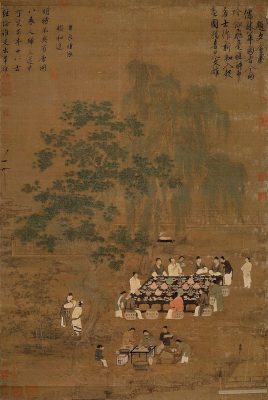The Song Dynasty (AD 960-1279) is divided into two periods: the Northern Song (960-1127) and the Southern Song (1127-1279). This division is based on the location of the Song capital. The capital was based in the northern city of Bianjing (now Kaifeng) during the Northern Song Dynasty, while the capital was south of the Yangtze in Lin’an (now Hangzhou) during the Southern Song Dynasty. Overall, the Song Dynasty is considered a time of significant cultural advancements in China and was one of the most prosperous eras in all of Chinese history.
Bureaucracy and Civil Service
Individuals who wished to begin a career in government had to go through a relatively standardized set of steps:
- Pass the Imperial Examination.
- Obtain a government position through networking.
- Be promoted from office to office.
A career bureaucrat had the potential to climb very high up the ranks and achieve great success. This was because of how vital the bureaucracy was for maintaining order in Song China.
During the Northern Song Dynasty, a greater number of people entered government service than ever before. One aspect that distinguished Song Dynasty bureaucracy from the previous dynasties was their reliance on merit-based examinations. This began with the Tang and became more prevalent during the Song dynasty. Although not everyone could participate in government service, any male who passed the examination was allowed to take government positions if deemed qualified, rather than only the children of aristocrats and officials.
The Scholar-Gentry
The rise of meritocracy meant that many individuals who were not aristocrats now had the opportunity to join the bureaucracy, leading to the rise of a new class known as the “scholar-gentry.” This class of educated officials reached new heights of education and sophistication in Chinese society, and they were the ones who mainly staffed government offices and wrote Chinese literature during the Song dynasty. Their population increased to such an extent that, eventually, they outnumbered the aristocracy. They also served as role models for the general population, who began to see education as a way to improve their social status.
Technology
Many new technologies were developed during the Song Dynasty, including gunpowder, movable type printing, and the compass. This led to a more literate society, as well as new advances in warfare. The government of this era took advantage of technological advances in printing to facilitate widespread knowledge, allowing Chinese culture to flourish from within all aspects of society. For example, the Zizhi Tongjian, compiled by Sima Guang and published in 1084, is an enormous and comprehensive knowledge base containing details on China’s history, geography, and various other topics. This work is considered one of the four great books of Chinese historiography, alongside the Records of the Grand Historian, the Book of Documents, and the Spring and Autumn Annals.
Literature and Visual Arts
The cultural renaissance in the Song Dynasty was characterized by advancements in the visual arts, music, literature, and philosophy. Art appreciation reached new heights among the gentry class, who became major patrons of the arts. Painting styles developed and changed during this period, moving away from earlier dynasties’ static and formalized styles. Still, the art and culture of this time were largely influenced by Neo-Confucian ideals, especially that of the Zhu Xi school. This was also a golden age for Chinese literature, with remarkable advances in poetry, fiction, and historiography. Some of the most famous art and literature from this era, including the “Four Great Classical Novels” and painter Zhang Zeduan’s “Along the River During the Qingming Festival,” continue to be acclaimed today.
Social Norms and Values
Confucian ideals of filial piety and loyalty to one’s family and friends were prevalent during the Song Dynasty. Family relationships were extremely important in traditional Confucian culture. There was an emphasis on respecting and obeying your parents. Society was male-dominated, and women were generally seen as inferior to men. However, there was a little bit more gender equality in the Song Dynasty compared to earlier dynasties. Some women were able to become military leaders, including Liang Hong Yu, a well-known general during the Southern Song Dynasty. Generally, women were also allowed to operate their own businesses. However, on the other side of the coin, certain social norms that were harmful to women, such as foot-binding, were still common during this time. It was believed that small feet indicated beauty and attractiveness, so women were forced to bind their feet at a young age to make them appear smaller.
Conclusion
In conclusion, the Song Dynasty was a time of great cultural advancement in China. Many new technologies were developed, literature and visual arts flourished, and Confucian ideals continued to be influential. However, society was still male-dominated, and there were some harmful social norms that developed during this period as well. Ultimately, the cultural advancements of this time, combined with its various challenges, are what makes it such a critical period in Chinese history. Whether it be through its artistic achievements or intellectual accomplishments, the legacy of the Song Dynasty can still be seen in China today.
